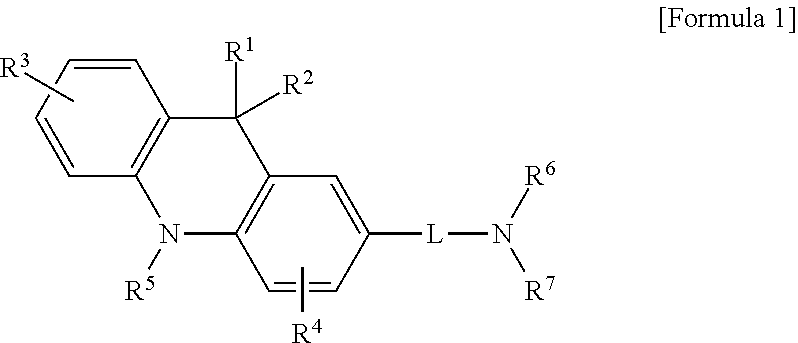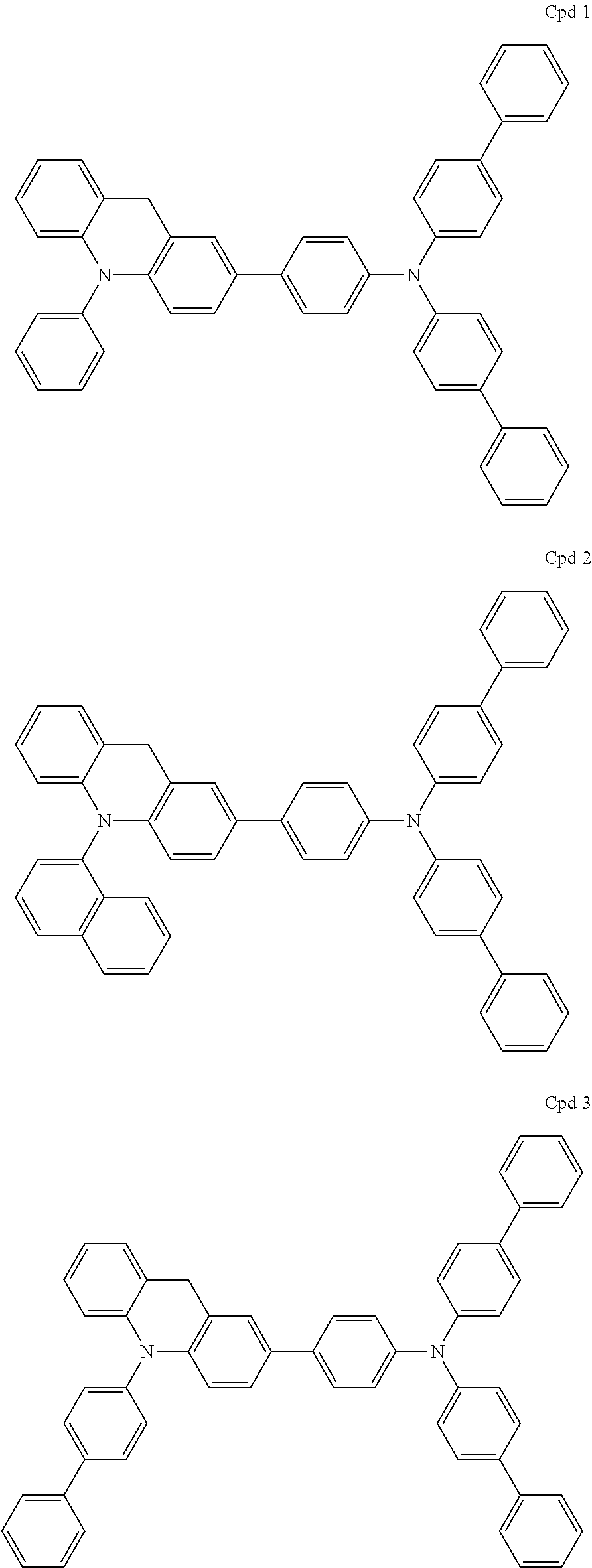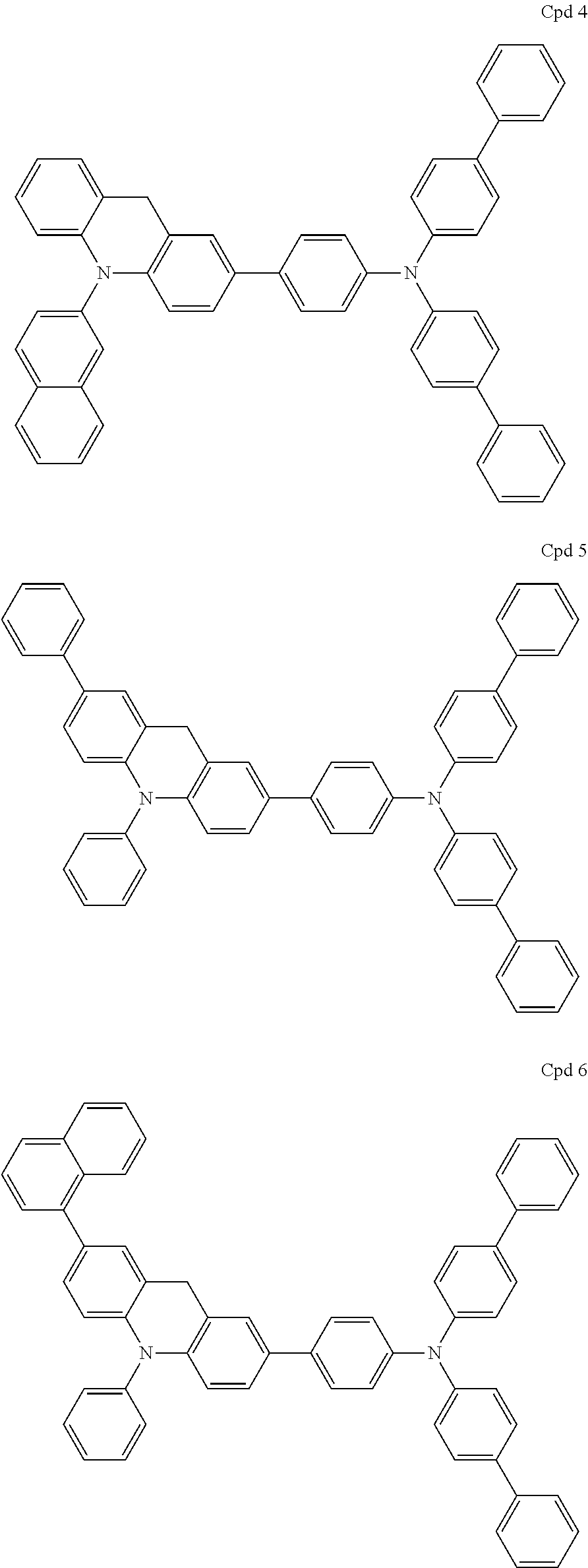Acridine derivative and organic electroluminescence device including the same
- Summary
- Abstract
- Description
- Claims
- Application Information
AI Technical Summary
Benefits of technology
Problems solved by technology
Method used
Image
Examples
synthesis example 1
Synthesis of Cpd 14 Compound
Synthesis Example 1-1
Synthesis of 9,10-dihydroacridine of Reaction Scheme 1
[0038]Under a nitrogen atmosphere, acridine (17.19 g, 95.92 mmol) and THF (300 ml) were introduced into a round-bottom flask. At 0° C., LiAlH4 (14.56 g, 383.66 mmol) was slowly added in halves twice thereto, followed by stirring at room temperature for 4 hours. At 0° C., the resultant product was slowly added with a sodium bicarbonate solution, and then extracted with methylene chloride and distilled water. The extracted layer was dried with sodium sulfate so as to filtrate and concentrate an organic solvent. Then, the resultant product was columned by methylene chloride and hexane (n-Hexane:MC=8:2) so as to obtain a required compound, 9,10-dihydroacridine (white solid, 14 g, 82%).
[0039]1H NMR: 3.8 (s, 2H), 4.0 (s, 1H), 6.3 (t, 2H), 6.5 (dd, 2H), 6.8 (m, 4H).
synthesis example 1-2
Synthesis of 10-(biphenyl-4-yl)-9,10-dihydroacridine of Reaction Scheme 1
[0040]The obtained 9,10-dihydroacridine (11.8 g, 65.2 mmol) and 4-bromobiphenyl (18.2 g, 78.2 mmol) were dissolved in toluene (500 mL). Then, Pd2(dba)3 (1.4 g, 1.3 mmol) was added thereto under a nitrogen atmosphere. Then, NaOBut (9.4 g, 97.8 mmol) was added thereto, and (t-Bu)3P (1.6 ml, 2.6 mmol) was introduced to the resultant solution. The resultant mixture was reflux-stirred for 5 hours. The completion of the reaction was identified by a TLC. After the reaction was completed, the mixture was cooled to room temperature. The resultant solution was poured onto a thin silica pad so as to perform a short chromatography, and then was washed with MC. The filtrate was evaporated under a reduced pressure to remove the solvent. The residue was then purified by silica gel column chromatography (methylene chloride / n-hexane (1 / 10)) to obtain 10-(biphenyl-4-yl)-9,10-dihydroacridine compound (pale yellow solid, 15.3 g, y...
synthesis example 1-3
Synthesis of 10-(biphenyl-4-yl)-2-bromo-9,10-dihydroacridine of Reaction Scheme 1
[0042]The obtained 10-(biphenyl-4-yl)-9,10-dihydroacridine (15.3 g, 45.9 mmol) was added with chloroform (500 ml), and then with bromosuccinimide (9.8 g, 55.1 mmol). The resultant solution was stirred at room temperature for 2 hours. After the reaction was completed, the resultant solution was washed with distilled water. Then, an organic layer was extracted and dried with sodium sulfate so as to remove the solvent. The residue was purified by silica gel column chromatography (methylene chloride / n-hexane (1 / 20)) to obtain 10-(biphenyl-4-yl)-2-bromo-9,10-dihydroacridine compound (white solid, 14.7 g, yield 77%).
[0043]1H NMR: 3.8 (s, 2H), 6.2 (d, 1H), 6.3 (t, 1H), 6.5 (d, 2H), 6.8 (m, 2H), 6.9 (m, 2H), 7.6 (m, 5H), 7.9 (t, 2H).
PUM
 Login to View More
Login to View More Abstract
Description
Claims
Application Information
 Login to View More
Login to View More - R&D
- Intellectual Property
- Life Sciences
- Materials
- Tech Scout
- Unparalleled Data Quality
- Higher Quality Content
- 60% Fewer Hallucinations
Browse by: Latest US Patents, China's latest patents, Technical Efficacy Thesaurus, Application Domain, Technology Topic, Popular Technical Reports.
© 2025 PatSnap. All rights reserved.Legal|Privacy policy|Modern Slavery Act Transparency Statement|Sitemap|About US| Contact US: help@patsnap.com



